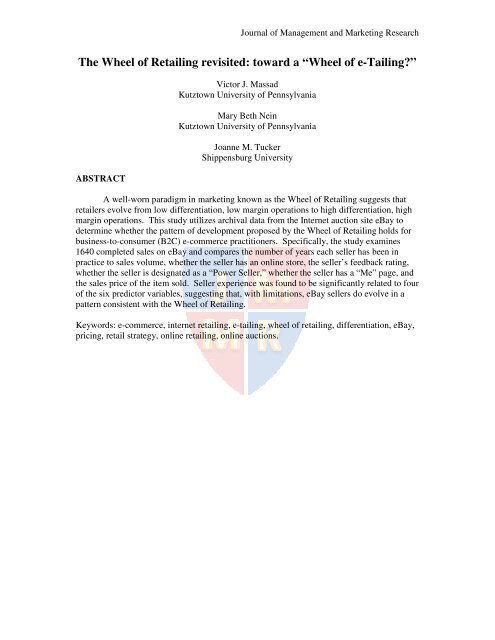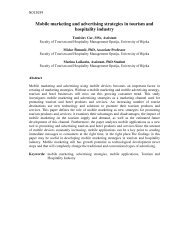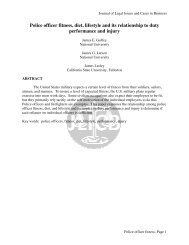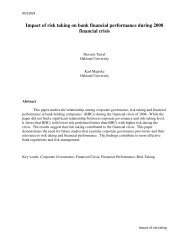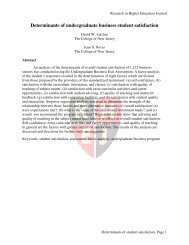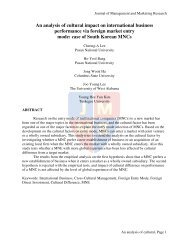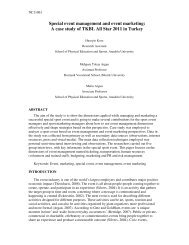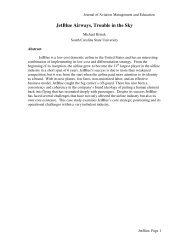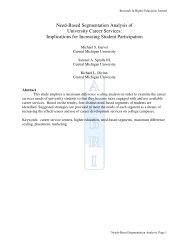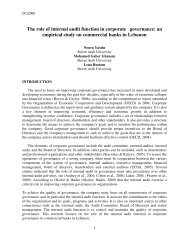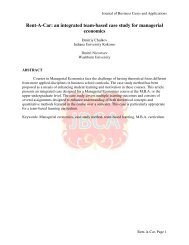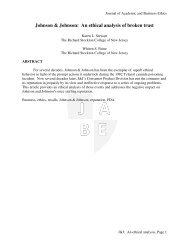The Wheel of Retailing revisited: t of Retailing revisited: toward a ...
The Wheel of Retailing revisited: t of Retailing revisited: toward a ...
The Wheel of Retailing revisited: t of Retailing revisited: toward a ...
You also want an ePaper? Increase the reach of your titles
YUMPU automatically turns print PDFs into web optimized ePapers that Google loves.
<strong>The</strong> <strong>Wheel</strong> <strong>of</strong> <strong>Retailing</strong> <strong>revisited</strong>: <strong>toward</strong> a “<strong>Wheel</strong> <strong>of</strong> ee-Tailing?”<br />
Tailing?”<br />
ABSTRACT<br />
Journal <strong>of</strong> Management and Marketing Research<br />
Victor J. Massad<br />
Kutztown University <strong>of</strong> Pennsylvania<br />
Mary Beth Nein<br />
Kutztown University <strong>of</strong> Pennsylvania<br />
Joanne M. Tucker<br />
Shippensburg University<br />
A well-worn worn paradigm in marketing known as the <strong>Wheel</strong> <strong>of</strong> <strong>Retailing</strong> suggests that<br />
retailers retailers evolve evolve from from low low differentiation, differentiation, low margin margin operations to to high high differentiation, differentiation, high<br />
margin margin operations. operations. This This study study utilizes utilizes archival archival data from from the the Internet Internet auction auction site site eBay to<br />
determine whether ether the the pattern pattern <strong>of</strong> <strong>of</strong> development proposed proposed by by the <strong>Wheel</strong> <strong>Wheel</strong> <strong>of</strong> <strong>Retailing</strong> holds for<br />
business-to-consumer (B2C) e-commerce commerce practitioners. practitioners. Specifically, Specifically, the the study study examines<br />
examines<br />
1640 1640 completed completed sales sales on on eBay eBay and and compares compares the the number number <strong>of</strong> <strong>of</strong> years each seller seller has been in<br />
practice ice to to sales sales volume, whether whether the the seller seller has has an an online online store, the seller’s feedback rating,<br />
whether whether the the seller seller is is designated designated as as a a “Power “Power Seller,” Seller,” whether whether the the seller seller has has a a “Me” “Me” page, page, and<br />
and<br />
the sales price <strong>of</strong> the item sold. Seller experience was found to be significantly related to four<br />
<strong>of</strong> <strong>of</strong> the the six six predictor predictor variables, variables, suggesting suggesting that, that, with with limitations, eBay sellers do evolve in a<br />
pattern consistent with the <strong>Wheel</strong> <strong>of</strong> <strong>Retailing</strong>.<br />
Keywords: e-commerce, commerce, internet retailing, ee-tailing,<br />
tailing, wheel <strong>of</strong> retailing, differentiation, differentia eBay,<br />
pricing, retail strategy, online retailing, online auctions.
INTRODUCTION AND BACKGROUND<br />
Journal <strong>of</strong> Management and Marketing Research<br />
One <strong>of</strong> the oldest paradigms in modern retailing is known as “<strong>The</strong> <strong>Wheel</strong> <strong>of</strong><br />
<strong>Retailing</strong>” (WOR). <strong>The</strong> framework was developed in the 1950’s in order to establish a<br />
theoretical basis for understanding the rapid growth and development <strong>of</strong> post<br />
in western industrialized nations. As<br />
21 st century, there has occurred a similar, though less visible, growth and development<br />
on the electronic platform known as<br />
online retail experience to observe, the question arises as to whether<br />
between the post-war boom in brick and mortar retailing and the more recent evolution <strong>of</strong> e<br />
tailing.<br />
<strong>The</strong> <strong>Wheel</strong> <strong>of</strong> <strong>Retailing</strong> was originally developed by Pr<strong>of</strong>essor Malcolm P. McNair in<br />
1958. McNair reasoned that when start<br />
under the premise <strong>of</strong> being low-price, low margin performers. <strong>The</strong>y d<br />
most cost-effective way to acquire as many customers as possible to make a mark in their<br />
competitive fields <strong>of</strong> choice. As<br />
realization that not all customers are created equal. Thus, the retailer<br />
will seek out those customers who are loyal<br />
Over time the retailer will tend to focus his business on these higher margin customers,<br />
leaving the lower margin customers to new market entrants<br />
<strong>The</strong> <strong>Wheel</strong> <strong>of</strong> <strong>Retailing</strong> is one <strong>of</strong> the oldest theoretical constructs in the marketing<br />
discipline, and continues to be cited in<br />
example, Kotler & Keller 2009). <strong>The</strong> framework<br />
paradigm in the academic literature through the 1960’s and early 1970’s. As late a<br />
was used to provide a theoretical foundation for identifying variables that were likely to<br />
contribute to a retailer “trading up” by <strong>of</strong>fering a greater number <strong>of</strong> services (Goldman 1975).<br />
As new patterns in retailing began to emerge in the latter<br />
to be regarded less favorably as an adequate paradigm to explain many <strong>of</strong> the trends <strong>of</strong> that<br />
time. Kalkati (1985) pointed out that many high margin retailers, contrary to the pattern<br />
proposed by WOR, were lowering prices<br />
entering the market. May (1989) pointed out that deficiencies were appearing in the<br />
framework based on the speed at which retailing was changing, the fact that many retailers<br />
were past maturity, and that there were retail forms that had come into being in a<br />
was contrary to that predicted by WOR.<br />
<strong>The</strong> emergence <strong>of</strong> huge discount bricks<br />
Home Depot in the late 20 th One <strong>of</strong> the oldest paradigms in modern retailing is known as “<strong>The</strong> <strong>Wheel</strong> <strong>of</strong><br />
). <strong>The</strong> framework was developed in the 1950’s in order to establish a<br />
theoretical basis for understanding the rapid growth and development <strong>of</strong> post-WWII retailers<br />
in western industrialized nations. As retail practitioners head into the second decade <strong>of</strong> the<br />
a similar, though less visible, growth and development<br />
on the electronic platform known as the worldwide web. With more than a decade <strong>of</strong> robust<br />
online retail experience to observe, the question arises as to whether there might be parallels<br />
war boom in brick and mortar retailing and the more recent evolution <strong>of</strong> e<br />
<strong>The</strong> <strong>Wheel</strong> <strong>of</strong> <strong>Retailing</strong> was originally developed by Pr<strong>of</strong>essor Malcolm P. McNair in<br />
1958. McNair reasoned that when start-up retailers enter a consumer market, they operate<br />
price, low margin performers. <strong>The</strong>y do this because it is the<br />
effective way to acquire as many customers as possible to make a mark in their<br />
a particular retailer acquires customers, he will<br />
that not all customers are created equal. Thus, the retailer, as a matter <strong>of</strong> course<br />
customers who are loyal, buy <strong>of</strong>ten and are willing to pay for added value.<br />
Over time the retailer will tend to focus his business on these higher margin customers,<br />
leaving the lower margin customers to new market entrants (Hollander, 1960).<br />
<strong>The</strong> <strong>Wheel</strong> <strong>of</strong> <strong>Retailing</strong> is one <strong>of</strong> the oldest theoretical constructs in the marketing<br />
cipline, and continues to be cited in marketing and retailing textbooks today (see, for<br />
example, Kotler & Keller 2009). <strong>The</strong> framework survived as a relatively unchallenged<br />
in the academic literature through the 1960’s and early 1970’s. As late a<br />
was used to provide a theoretical foundation for identifying variables that were likely to<br />
contribute to a retailer “trading up” by <strong>of</strong>fering a greater number <strong>of</strong> services (Goldman 1975).<br />
As new patterns in retailing began to emerge in the latter part <strong>of</strong> the 20<br />
century played a significant role in causin<br />
<strong>Retailing</strong> to become out <strong>of</strong> favor among academic researchers. <strong>The</strong>se large retailers started<br />
out as large discounters, and maintained their identity as large retailers as time went on.<br />
Since they had become dominant in the marketplace with t<br />
lost its relevance as anything more than an historical oddity ins<strong>of</strong>ar as being a robust model<br />
for explaining and predicting retail behavior.<br />
advocates concluded that “the number<br />
hypothesis is not valid for all retailing (Hollander 1996).”<br />
One purpose <strong>of</strong> this research is to examine the more recent phenomenon <strong>of</strong> Internet<br />
based retailing through the lens <strong>of</strong> the <strong>Wheel</strong> <strong>of</strong> <strong>Retailing</strong> and<br />
provides a theoretical basis for understanding the evolution <strong>of</strong> e<br />
Can this relic from the 1950’s and 60’s<br />
in post-war retailing -- be dusted <strong>of</strong><br />
Internet Marketing some 50 years later? Whether the domain is real or virtual, there may be<br />
certain consistencies that occur, especially among smaller retailers, as businesses with limited<br />
th One <strong>of</strong> the oldest paradigms in modern retailing is known as “<strong>The</strong> <strong>Wheel</strong> <strong>of</strong><br />
). <strong>The</strong> framework was developed in the 1950’s in order to establish a<br />
WWII retailers<br />
head into the second decade <strong>of</strong> the<br />
a similar, though less visible, growth and development based<br />
more than a decade <strong>of</strong> robust<br />
there might be parallels<br />
war boom in brick and mortar retailing and the more recent evolution <strong>of</strong> e-<br />
<strong>The</strong> <strong>Wheel</strong> <strong>of</strong> <strong>Retailing</strong> was originally developed by Pr<strong>of</strong>essor Malcolm P. McNair in<br />
rs enter a consumer market, they operate<br />
this because it is the<br />
effective way to acquire as many customers as possible to make a mark in their<br />
will come to the<br />
as a matter <strong>of</strong> course,<br />
willing to pay for added value.<br />
Over time the retailer will tend to focus his business on these higher margin customers,<br />
.<br />
<strong>The</strong> <strong>Wheel</strong> <strong>of</strong> <strong>Retailing</strong> is one <strong>of</strong> the oldest theoretical constructs in the marketing<br />
textbooks today (see, for<br />
relatively unchallenged<br />
in the academic literature through the 1960’s and early 1970’s. As late as 1975 it<br />
was used to provide a theoretical foundation for identifying variables that were likely to<br />
contribute to a retailer “trading up” by <strong>of</strong>fering a greater number <strong>of</strong> services (Goldman 1975).<br />
century, WOR came<br />
to be regarded less favorably as an adequate paradigm to explain many <strong>of</strong> the trends <strong>of</strong> that<br />
time. Kalkati (1985) pointed out that many high margin retailers, contrary to the pattern<br />
proposed by WOR, were lowering prices in response to the proliferation <strong>of</strong> big discounters<br />
entering the market. May (1989) pointed out that deficiencies were appearing in the<br />
framework based on the speed at which retailing was changing, the fact that many retailers<br />
there were retail forms that had come into being in a manner that<br />
contrary to that predicted by WOR.<br />
<strong>The</strong> emergence <strong>of</strong> huge discount bricks-and-mortar mortar retailers such as Walmart and<br />
century played a significant role in causing g the <strong>Wheel</strong> <strong>of</strong><br />
<strong>Retailing</strong> to become out <strong>of</strong> favor among academic researchers. <strong>The</strong>se large retailers started<br />
out as large discounters, and maintained their identity as large retailers as time went on.<br />
Since they had become dominant in the marketplace with the he strategy, it appeared WOR had<br />
lost its relevance as anything more than an historical oddity ins<strong>of</strong>ar as being a robust model<br />
for explaining and predicting retail behavior. By 1996 one <strong>of</strong> the WOR’s strongest academic<br />
he number <strong>of</strong> nonconforming examples suggests that the wheel<br />
hypothesis is not valid for all retailing (Hollander 1996).”<br />
One purpose <strong>of</strong> this research is to examine the more recent phenomenon <strong>of</strong> Internet-<br />
based retailing through the lens <strong>of</strong> the <strong>Wheel</strong> <strong>of</strong> <strong>Retailing</strong> and to determine whether WOR<br />
provides a theoretical basis for understanding the evolution <strong>of</strong> e-tailing tailing since the late 1990’s.<br />
Can this relic from the 1950’s and 60’s – a device so useful in bringing into focus the growth<br />
be dusted <strong>of</strong>f f and be made useful again as we examine the growth <strong>of</strong><br />
Internet Marketing some 50 years later? Whether the domain is real or virtual, there may be<br />
certain consistencies that occur, especially among smaller retailers, as businesses with limited
esources make ake decisions decisions in in an an environment environment in in which which markets markets are expanding expanding and<br />
and<br />
opportunities developing.<br />
With the advent <strong>of</strong> Internet retailing, many first first-time time business owners have turned to<br />
various auctions sites such as eBay to “get their foot in the door.” <strong>The</strong>se si sites tes make it<br />
relatively relatively simple simple to see if there there is a a market market to to sell the products a a new new business owner owner will<br />
provide, provide, and and at at a a minimal minimal cost as as compared to a bricks and mortar business. business. After After nearly 20<br />
years in business, Internet-based based companies such as eBay ma may y be showing signs <strong>of</strong> maturity<br />
indicative <strong>of</strong> a pattern predicted by WOR.<br />
Other research indicates that sellers seller with positive track records at sites such as eBay<br />
and and Amazon Amazon are are able to to command command higher prices prices by virtue <strong>of</strong> <strong>of</strong> the the fact fact that that posted posted feedback<br />
feedback<br />
from previous previous customers customers adds adds value in the the form <strong>of</strong> information as to to how how their their businesses are<br />
performing performing in in terms <strong>of</strong> <strong>of</strong> product quality, delivery delivery timeliness and other dimensions <strong>of</strong><br />
<strong>of</strong><br />
importance to buyers (Gurtler & Grund, 2006) 2006). If this relationship between online seller<br />
standing and price is valid, , then then it it stands stands to reason reason that as sellers sellers mature, mature, they they would would tend to<br />
to<br />
“cherry “cherry pick” pick” the more risk risk averse averse buyers buyers who who seek reassurance reassurance about about seller seller reputation. reputation. This<br />
This<br />
is particularly true when it comes omes to online auction auction sites sites because such sites sites have have a reputation<br />
for being rife with unreliability and fraud (Li, Srinivasan, & Sun, 2009). . Other forms <strong>of</strong> etailing<br />
tailing are not immune from buyer buyer concerns concerns about safety, either, as research research indicates indicates that<br />
that<br />
consumers mers are are particularly wary wary when purchasing over the Internet; heavy shoppers are<br />
significantly significantly more more likely likely to to analyze attributes attributes such as trustworthiness trustworthiness when purchasing online<br />
online<br />
(Chiou & Pan, 2009).<br />
<strong>The</strong> original vision <strong>of</strong> the Internet was that it would cr create eate a “one world/one price”<br />
global global marketplace marketplace in in which which there was virtually no information asymmetry between buyers<br />
buyers<br />
and and sellers. sellers. While While the the Internet Internet has has unquestionably unquestionably closed information gaps that existed prior<br />
to its widespread usage by consumers, it has fallen well short <strong>of</strong> delivering market perfection,<br />
as as retailers retailers develop develop new and and clever clever means means <strong>of</strong> <strong>of</strong> “obfuscation” “obfuscation” that that change change customer focus focus from<br />
from<br />
price to other dimensions (Ellison and Ellison 2009). What an economist terms<br />
“obfuscation” a marketer might cal call l “differentiation.” Nonetheless, the purpose remains the<br />
same: same: to to discourage customers customers from from engaging engaging in in further further information search and to provoke<br />
them into paying higher prices.<br />
THEORETICAL UNDERPINNINGS<br />
Journal <strong>of</strong> Management and Marketing Research<br />
<strong>The</strong> hypothetical reasoning <strong>of</strong> the <strong>Wheel</strong> <strong>of</strong> Reta <strong>Retailing</strong> iling can be described as a simple<br />
syllogism syllogism <strong>of</strong> <strong>of</strong> the the following following progression: progression: (1) (1) new new retailers retailers are are more more interested interested in in gathering<br />
gathering<br />
customers than in making making pr<strong>of</strong>its; pr<strong>of</strong>its; (2) older older retailers retailers are more more interested interested in in making making pr<strong>of</strong>its<br />
than gathering customers; (3) the most efficient way to gather new customers is to charge a<br />
lower lower price; price; (4) (4) therefore, as as a retailer retailer matures, matures, it it will will become more more focused focused on on higher higher prices<br />
prices<br />
and and pr<strong>of</strong>its, pr<strong>of</strong>its, and less focused focused on gathering gathering new customers. This This logic logic is is graphically expressed<br />
expressed<br />
in Figure 1 (Appendix). . <strong>The</strong> figure indicates that that as time time goes on, total sales sales will will increase,<br />
increase,<br />
the size <strong>of</strong> the average sale will increase increase at a greater rate than than total sales, sales, and that the number<br />
<strong>of</strong> potential customers within the market served by the retailer will decline. Size <strong>of</strong> potential<br />
market decreases for older e-tailers tailers because they will tend to be focused on potential markets market<br />
whose whose customers buy more more frequently and want value added or differentiation that that new e-<br />
tailers cannot, or do not, provide. Average sales price increases for older e-tailers tailers because <strong>of</strong><br />
the value added features or differentiation they provide. Total sales will increase for older e-<br />
tailers because <strong>of</strong> two factors: (1) higher average sales; and (2) larger number <strong>of</strong> transactions<br />
by virtue <strong>of</strong> experienced retailers capturing more attractive higher usage segments.<br />
Ba, Stallaert and Zhang (2007) point out that ee-tailers<br />
tailers face a tremendous challenge<br />
compared to traditional brick-and and-mortar mortar retailers because consumers on the Internet have far
Journal <strong>of</strong> Management and Marketing Research<br />
greater ter information information available available to to them them prior prior to to making making purchase purchase decisions; and and because because <strong>of</strong> the<br />
sheer sheer volume volume <strong>of</strong> <strong>of</strong> competitors, competitors, charging charging the the lowest lowest price price does not not guarantee guarantee that that any particular<br />
e-tailer tailer will gain an advantage. Thus, ee-tailers<br />
must develop a way to differentiate ifferentiate<br />
themselves with non-price price attributes such as service quality and merchant merchant brand recognition.<br />
This is no doubt a reality that Internet-based Internet based retailers discover over time. Since brand<br />
recognition, reputation and many other sources <strong>of</strong> differentiation take time to develop, it<br />
follows that more mature e-tailers tailers would tend to be more focused on differentiating<br />
themselves than newer e-tailers.<br />
Internet Internet retailers retailers must incorporate incorporate selling strategies that will allow buyers buyers to sense sense the<br />
the<br />
product in all aspects: spects: visual, audio audio and kinesthetic. kinesthetic. Sellers must be mindful that that most most <strong>of</strong> <strong>of</strong> their<br />
their<br />
customers are “goal-directed.” directed.” Buyers Buyers usually have have a specific buying buying objective in in mind when<br />
they search for retail websites to purchase an item (Mathwick, Malhotra, & Rigdon Rigdon, 2002).<br />
Another way for e-tailers tailers to to signal signal to to consumers consumers that they can expect expect higher levels <strong>of</strong><br />
<strong>of</strong><br />
differentiation differentiation is to to charge charge higher prices. Mitra and and Fay (2010) suggested suggested that that the potential<br />
sources <strong>of</strong> differentiation available to online retailers were co considerably nsiderably fewer in number than<br />
those available to traditional bricks-and-mortar bricks mortar retailers. Thus, online retailers were more<br />
likely to use higher price to signal differentiation than their bricks-and-mortar bricks mortar counterparts.<br />
<strong>The</strong>se researchers found that e-ta tailers ilers at both ends <strong>of</strong> the spectrum were more likely to<br />
manipulate price in order to manage service expectations.<br />
<strong>The</strong> <strong>The</strong> importance <strong>of</strong> <strong>of</strong> finding a source <strong>of</strong> competitive competitive advantage early early and and using using it it to<br />
to<br />
establish establish a a strong customer customer base base is is emphasized emphasized in in research by Pinguin and Talaga (2006),<br />
who found that early early entrants entrants to the Internet retail domain were able able to to more more efficiently efficie<br />
command command higher higher customer share share than late late movers. This would would be be congruent congruent with with the WOR<br />
postulation that older e-tailers tailers would would be more likely to have established sources <strong>of</strong><br />
<strong>of</strong><br />
differentiation than newer retailers.<br />
As for cost and price-oriented oriented ee-tailers,<br />
there may be less opportunity to capitalize on<br />
having having a lower lower cost cost structure structure than more established established competitors. competitors. <strong>The</strong>re <strong>The</strong>re is is some some evidence<br />
evidence<br />
from extant research that cost-based based competitors competitors on on the the Internet Internet are are more more likely likely to to spurn<br />
expensive graphic interfaces and nd less likely to <strong>of</strong>fer money-back money guarantees (Li, Srinivasan,<br />
& Sun, 2009). . Shipping and handling costs are another area where ee-tailers<br />
tailers may vary<br />
strategies. strategies. Under Under the assumption assumption that that buyers buyers may be more focused focused on on selling selling price, price, some<br />
some<br />
discount Internet sellers ellers charge inflated inflated shipping and handling costs and recover some <strong>of</strong> the<br />
deficiency that might occur from charging a lower top top-line price (Gurtler & Grund, 2006). 2006)<br />
<strong>The</strong>re is also evidence that larger discounters are utilizing drop-shipping drop shipping <strong>of</strong> standardized<br />
products to reduce shipping costs (Tsai & Hung, 2009).<br />
Taking Taking into into the the consideration consideration the original paradigm and and subsequent subsequent literature, the<br />
WOR predicts that there will be differences between experienced retailers and inexperienced<br />
retailers in terms <strong>of</strong> differentiation, ferentiation, volume volume and pricing. Experienced retailers will will be be more<br />
more<br />
oriented oriented <strong>toward</strong> <strong>toward</strong> higher higher differentiation differentiation as a a source <strong>of</strong> <strong>of</strong> competitive advantage; advantage; whereas, less<br />
less<br />
experienced experienced retailers retailers will will be be more more oriented <strong>toward</strong> <strong>of</strong>fering <strong>of</strong>fering lower lower prices prices and and less<br />
less<br />
differentiation. on. By By virtue <strong>of</strong> <strong>of</strong> their experience experience advantage, higher higher experienced retailers can be<br />
be<br />
expected to have higher overall sales volume than less experienced retailers. However, the<br />
growth growth rate rate in margins margins would be be expected to to exceed the the growth growth rate rate in sales. Less Les<br />
experienced retailers would be expected to have lower overall volume, , with the growth rate<br />
in in sales sales exceeding exceeding the the growth rate rate in margins. By virtue virtue <strong>of</strong> <strong>of</strong> their greater greater dependency dependency on<br />
on<br />
differentiation, experienced retailers would be expected to have higher av average erage sales and<br />
higher higher prices than than their their less experienced experienced counterparts. <strong>The</strong>se <strong>The</strong>se relationships relationships are are illustrated in<br />
Figure 2 (Appendix).
Journal <strong>of</strong> Management and Marketing Research<br />
RESEARCH OBJECTIVE, METHODOLOGY, AND HYPOTHESES<br />
<strong>The</strong> primary objective <strong>of</strong> this study is to examine the degree to which the <strong>Wheel</strong> <strong>of</strong><br />
<strong>Retailing</strong> model might apply to ee-tailers<br />
in the Internet environment; as it had in the past to<br />
retailers in the traditional brick-and and-mortar environment. <strong>The</strong> underlying question focused<br />
upon is: to what extent, if any, do does the <strong>Wheel</strong> <strong>of</strong> <strong>Retailing</strong> ling model have relevance to ee-tailers<br />
and their sales evolution in terms <strong>of</strong> pricing, differentiation and volume?<br />
In order to examine whether the relationships suggested by the WOR in the foregoing<br />
might hold in an authentic e-tailing tailing environment, a num number <strong>of</strong> Internet-based based archival data<br />
sources sources were were considered, including including information information from Internet retail sites sites such as as Amazon,<br />
Amazon,<br />
Tiger Tiger Direct Direct and and other other online direct direct marketing firms. Unfortunately, Unfortunately, much much information<br />
information<br />
regarding these sellers is kept proprietary and therefore is inaccessible. Ultimately, the best<br />
source source <strong>of</strong> <strong>of</strong> comprehensive retail retail transactional transactional information information for the the purposes <strong>of</strong> examining<br />
Internet retail activity was found at the auction site eBay. This well well-established established online<br />
intermediary keeps extensive sive records records about sellers, sellers, including their track records records and and levels levels <strong>of</strong><br />
experience, and this data is readily available to buyers and the general public.<br />
An An ordinary least least squares squares regression model was used used to study study the the relationships<br />
relationships<br />
between the variables. <strong>The</strong> <strong>The</strong> eBay eBay population <strong>of</strong> listings considered considered in our study study included the<br />
broad array <strong>of</strong> products available on the site site, with the exception <strong>of</strong> automobiles. A sample<br />
made up <strong>of</strong> 1640 eBay completed sales were selected at random. <strong>The</strong> large sample allowed<br />
for sampling from eBay’s diverse population <strong>of</strong> listings and included sales <strong>of</strong> items ranging<br />
from from an an audio audio CD CD at at 49 49 cents cents to to a a rare rare antique antique vase with with a a final final price <strong>of</strong> <strong>of</strong> $1750. $1750. <strong>The</strong>refore,<br />
sales were represented from numerous and highly disparate eBay sales catego categories ries ranging<br />
from consumer electronics to fashion clothing. clothing For each listing, values for seven seller-<br />
related variables were noted. <strong>The</strong>se variables are: (1) ) <strong>The</strong> number <strong>of</strong> years the seller has been<br />
registered on eBay (YRS) which is our dependent variable variable; (2) <strong>The</strong> total number <strong>of</strong> feedbacks<br />
(FDBCKS) (FDBCKS) accumulated accumulated by by a a seller seller divided divided by YRS YRS defined defined the the variable VOLUME; ( ( 33)<br />
3 Did<br />
the seller operated an eBay store or not (STORE); (4) <strong>The</strong> he seller’s feedback rating<br />
(RATING); (5) Was the seller was an eBay Power Seller Selle or not (POWSEL); (6) ) Did the seller<br />
have a “Me” Page (MEPAGE); ); and and (7.) (7.) <strong>The</strong> <strong>The</strong> sales sales price price <strong>of</strong> the the item item sold sold (PRICE). Both<br />
quantitative and categorical measures measures were were helpful helpful in examining the research research objective and<br />
drawing conclusions.<br />
<strong>The</strong> WOR predicts that there will be differences between experienced retailers and<br />
inexperienced retailers in terms <strong>of</strong> differentiation<br />
differentiation, , volume and pricing. For this study, we<br />
measured measured differentiation differentiation by by whether experienced eBay sellers used differentiation tactics<br />
such as having an an eBay eBay store, store, qualified qualified to to be be considered considered as as a a Power Power Seller and and having having an<br />
About Me page. Thus, we measured differentiation through STORE, POWSEL, POWSEL MEPAGE<br />
variables. variables. We We measured measured a seller’s seller’s volume through through the variables VOLUME and RATING.<br />
Lastly, we measured pricing through the variable PRICE PRICE. <strong>The</strong> research hypotheses that relate<br />
to these differences are:<br />
H1: Experienced eBay sellers will have higher annual sales volumes as measured by number<br />
<strong>of</strong> transactions than inexperienced eBay sellers sellers, indicated by the variable VOLUME.<br />
H2: Experienced eBay sellers will be more likely to have an eBay store than inexperienced<br />
eBay sellers as measured by the variable STORE.<br />
H3: H3: Experienced Experienced eBay sellers sellers will have higher higher feedback ratings ratings than than inexperienced inexperienced eBay<br />
eBay<br />
sellers as measured by the variable RATING.
H4: Experienced eBay sellers will be more likely to have Power Seller status than<br />
inexperienced eBay sellers as measured by the variable POWSEL. POWSEL<br />
H5: Experienced eBay sellers will be more likely to have a “Me” page than inexperienced<br />
sellers as measured by the variable MEPAGE.<br />
H6: H6: Experienced Experienced eBay sellers sellers will be more likely likely to to sell items with with higher higher prices prices than<br />
than<br />
inexperienced sellers as measured by the variable PRICE.<br />
<strong>The</strong> six hypotheses were tested using ordinary least squares multiple regression<br />
analysis with the variable YRS entered as the dependent variable and RATING, STORE,<br />
POWSEL, MEPAGE, VOLUME and PRICE as predictor variables. H1 was tested by<br />
examining the correlation between YRS and VOLUME. H2 was tested by examining the<br />
correlation correlation between between YRS and and STORE. STORE. H3 was tested tested by examining the the correlation correlation between<br />
YRS YRS and and RATING. RATING. H4 H4 was was tested tested by by examining examining the correlation between between YRS and<br />
and<br />
POWSEL. POWSEL. H5 H5 was was tested tested by examining examining the correlation between YRS and MEPAGE. HH6<br />
H<br />
was tested by examining the correlation between YRS and PRICE.<br />
RESEARCH RESULTS<br />
Journal <strong>of</strong> Management and Marketing Research<br />
A A presentation <strong>of</strong> relevant relevant descriptive statistics for the data can can be found in in Figure 3<br />
(Appendix). . As As indicated indicated by by the the differences differences between the the means means and and medians medians for for the th<br />
variables variables VOLUME VOLUME and and PRICE, PRICE, these these two two variables are somewhat somewhat skewed. Nonetheless, Nonetheless, the<br />
statistical techniques used to analyze these data are robust (Hair 1992).<br />
Figure 4 shows the correlation between the dependent variable, variable YRS, and each <strong>of</strong> the<br />
independent variables. <strong>The</strong> ranking <strong>of</strong> these correlations are: (1). PRICE, (2). MEPAGE MEPAGE, (3)<br />
RATING, (4) VOLUME, (5) POW, (6) STORE STORE. . Note that the most highly correlated<br />
variables PRICE, MEPAGE and RATING are associated with a seller’s pricin pricing, g,<br />
differentiation and volume, respectively.<br />
Multicollinearity is an important consideration in this study and it does not appear to<br />
be present. <strong>The</strong> highest correlation between independent variables shown in Figure 4<br />
(Appendix) is .448, which is moderate. When comparing different regression models<br />
equations using STEPWISE, , the size and direction <strong>of</strong> the coefficients remain consistent. In<br />
addition, the rank <strong>of</strong> the coefficients based on their p-value is very similar to the ranking <strong>of</strong><br />
the correlations shown in YRS column in Figure 4. Lastly, the variance inflation factor (not<br />
shown in Figure 4) for for all all independent variables is is less less than than 3. 3. All All <strong>of</strong> <strong>of</strong> these these indicators indicators lead us<br />
us<br />
to believe that multicollinearity is not present present, , and therefore individual coefficients may be<br />
interpreted.<br />
<strong>The</strong> assumptions made by ordinary least squares regression model appear to hold for<br />
our our data data set. set. <strong>The</strong> <strong>The</strong> plot plot <strong>of</strong> <strong>of</strong> residuals against predicted value shows shows a random scatter pattern. A<br />
histogram <strong>of</strong> the residuals and normality plot show the distribution to be symmetrical and<br />
mound-shaped, , however some departure from the theoretical normal shape. However, as<br />
mentioned mentioned earlier ordinary least least squares regression regression model model is is robust with with respect respect to this<br />
assumption (Hair 1992). Thus, these hese indicators lead us to believe the data does not violate the<br />
least squares assumptions.<br />
<strong>The</strong> multiple regression equation based on 6 independent variables yielded a multiple<br />
correlation coefficient, R, , <strong>of</strong> .334 and a coefficient <strong>of</strong> determination, R-square, R <strong>of</strong> 11.2<br />
percent suggesting there are other variables beyond these that might be related to ee-tailer<br />
longevity. <strong>The</strong> entire model, , however, was regarded as strongly and significantly predictive<br />
<strong>of</strong> YRS (F=34.2, p-value=.4.49E 4.49E-39 as shown in Figure 5).
Figure 6 (Appendix) shows that <strong>of</strong> the six predictor variables, only POWSEL was<br />
found to be below the .05 threshold for significance, significance however the sample showed the<br />
relationship based was positive. . <strong>The</strong> variable, STORE, was significant, but was<br />
inconsistent with the corresponding hypothesis. Of the five significant variables, t<br />
showing the greatest linearity to the dependent variable was PRICE and as indicated in Table<br />
3 (Appendix).<br />
<strong>The</strong> ranking <strong>of</strong> independent variables based on their p-value p is PRICE, MEPAGE,<br />
RATING, VOLUME, STORE and POW similar to ranking <strong>of</strong> variables in Table 3 with the<br />
exception <strong>of</strong> POWSEL and STORE positions <strong>of</strong> 5<br />
STORE are moderately correlated which may be the source <strong>of</strong> the position re<br />
Overall, H1 (VOLUME), H3 (RATING),<br />
supported by our analysis. Thus, supports the WO<br />
experienced retailers and inexperienced retailers in terms <strong>of</strong> differentiation<br />
pricing. However, H2 (STORE)<br />
differentiation are not supported.<br />
th and 6 th only POWSEL was<br />
, however the sample showed the<br />
significant, but was directionally<br />
Of the five significant variables, the variable<br />
showing the greatest linearity to the dependent variable was PRICE and as indicated in Table<br />
is PRICE, MEPAGE,<br />
RATING, VOLUME, STORE and POW similar to ranking <strong>of</strong> variables in Table 3 with the<br />
are reversed. POWSEL and<br />
STORE are moderately correlated which may be the source <strong>of</strong> the position reversal. versal.<br />
(VOLUME), H3 (RATING), H5 (MEPAGE) and H6 (PRICE) are<br />
. Thus, supports the WOR constructs <strong>of</strong> differences between<br />
experienced retailers and inexperienced retailers in terms <strong>of</strong> differentiation, , volume and<br />
(STORE) and H4 (POWSEL) as surrogates for the construct <strong>of</strong><br />
are not supported.<br />
DISCUSSION<br />
Journal <strong>of</strong> Management and Marketing Research<br />
Apart from the results results reported reported in the previous section on on our six six research research hypotheses,<br />
hypotheses,<br />
there there are are a a number number <strong>of</strong> <strong>of</strong> interesting revelations regarding regarding eBay eBay and and its its evolution evolution as as an an online<br />
online<br />
retail facilitator that arose from the study. One was the degree to which larger sellers aaffect<br />
eBay’s eBay’s revenues, revenues, which which underscores the company’s shift shift in in strategic strategic direction from its<br />
traditional traditional posture posture as as an online auction auction site that that secondarily <strong>of</strong>fered fixed price price merchandise,<br />
to a fixed price priced site that secondarily <strong>of</strong>fers auction mercha merchandise ndise (Holahan 2008). With<br />
roughly roughly 20 20 percent percent <strong>of</strong> the the sellers sellers accounting for about about 85 85 percent percent <strong>of</strong> the the firm’s firm’s volume volume (nearly<br />
half half the volume volume being being accounted for by by the top 5 percent), it it is is not not surprising that eBay has<br />
embraced a business model that is more oriented <strong>toward</strong> maintaining price consistency and<br />
security than the turbulent and risk risk-oriented oriented marketplace that typified its earlier existence.<br />
<strong>The</strong> <strong>The</strong> fact that that VOLUME VOLUME was very significant is not surprising surprising since the the variable variable was a<br />
a<br />
ratio in which one <strong>of</strong> the components components was the dependent dependent variable. variable. However, the fact fact that it<br />
was was less significant significant than than PRICE was was very very revealing revealing since since it indicates that as sellers gain in<br />
experience experience selling selling on eBay eBay (and (and by by extension, online) they engage in more transactions at<br />
higher r average prices. This is consistent consistent with retail retail evolution predicted predicted according according to to <strong>The</strong><br />
<strong>The</strong><br />
<strong>Wheel</strong> <strong>of</strong> <strong>Retailing</strong> paradigm expressed in Figure 1.<br />
<strong>The</strong> fact that 43 percent <strong>of</strong> all sellers pay to maintain an eBay store (Table 2) 2), where<br />
the merchandise is inventoried longer longer-term term and sold at a fixed price, indicates that a large<br />
percentage percentage <strong>of</strong> <strong>of</strong> sellers are adapting to the new environment and and operating operating more more like like traditional<br />
retailers. retailers. This necessitates that sellers sellers maintain larger larger levels levels <strong>of</strong> working working capital and and endure<br />
higher er turnover rates in exchange for improved margins. <strong>The</strong> <strong>Wheel</strong> <strong>of</strong> <strong>Retailing</strong> provides an<br />
explanation explanation for for this this phenomenon, phenomenon, however however STORE was was not not found found to to be be significantly<br />
significantly<br />
correlated correlated to to longevity, and and in in fact fact the the model model yielded yielded a a reverse reverse relationship. One exp explanation exp<br />
is is that that eBay eBay may may more more recently recently be be attracting attracting retailers retailers that were were previously previously selling on fixed<br />
price price sites sites such as as Amazon. If this is the case, case, these retailers would would be newer to eBay but still<br />
quite experienced in online retailing.<br />
Slightly more than a third <strong>of</strong> the sellers in the study were identified as “Power<br />
Sellers.” Sellers.” In In order order to to become become a a Power Power Seller, Seller, a a seller seller must have sales consistently over one<br />
thousand thousand dollars dollars per per month, month, 98 98 percent feedback rating, and and average better than 4.5 stars (out<br />
<strong>of</strong> a possible five) ) on four service dimensions. This suggests that Power Sellers would<br />
necessarily necessarily be be more more focused focused on on the service dimensions <strong>of</strong> <strong>of</strong> their businesses businesses than other eBay<br />
sellers.
Journal <strong>of</strong> Management and Marketing Research<br />
Another interesting finding is that only 23 percent <strong>of</strong> the sellers utilized lized eBay’s<br />
“About Me” page as shown in Table 22.<br />
. <strong>The</strong> About Me page is a free feature that allows<br />
sellers sellers to create create an image for for themselves themselves and and perhaps perhaps draw some distinctions between<br />
themselves and other eBay sellers. Since having an About Me page is free e promotion, and<br />
given given that less less than a third <strong>of</strong> sellers sellers use it, it, a majority <strong>of</strong> <strong>of</strong> eBay sellers sellers may may not think non non-price non<br />
competition makes much <strong>of</strong> a difference on eBay. Consistent with WOR the ones that do<br />
tend to be more experienced as MEPAGE was a significant variable in this study.<br />
<strong>The</strong> <strong>The</strong> <strong>Wheel</strong> <strong>of</strong> <strong>Retailing</strong> <strong>Retailing</strong> appears to be a fairly fairly robust and and relevant framework framework for<br />
investigating the phenomena <strong>of</strong> e-tailer e tailer evolution, especially as it concerns the nature <strong>of</strong> small<br />
entrepreneurs who start on a shoestring and build their businesses from the ground up. This<br />
aptly aptly describes describes the the typical typical eBay seller, and so the model model is is a a good good one one for investigating this<br />
particular particular subset subset <strong>of</strong> online online retailers. <strong>The</strong>re is, is, however, however, another another group group <strong>of</strong> <strong>of</strong> online online business-to- business<br />
consumer (B2C) companies s that that begin begin with with large large sums sums from venture venture capitalists and start out<br />
as as large, large, well well capitalized capitalized firms firms with with experienced management. management. <strong>The</strong> WOR would not be<br />
expected to yield much in studies concerning these operations.<br />
Future research should focus on a number <strong>of</strong> areas, including: (1) identifying<br />
additional variables that might be related to e-tailer e tailer experience. Of particular interest are<br />
attitudinal variables such as opportunism, customer customer-service service orientation and intentions<br />
regarding future strategic direction directions; s; (2) developing a more comprehensive framework that<br />
may better explain the broader range <strong>of</strong> e-tailers e tailers beyond those who do business on eBay; and<br />
(3) examining the question <strong>of</strong> e-tailer tailer evolution based on any number <strong>of</strong> <strong>of</strong> possible sociological<br />
sociological<br />
or economic intervening rvening factors, factors, including including such things as industry, the the nature <strong>of</strong> <strong>of</strong> the product,<br />
product,<br />
the the size <strong>of</strong> the the organization, organization, the cost structure, and the corporate culture <strong>of</strong> the the firm.<br />
firm.<br />
In In conclusion, conclusion, it it can can be be said said that that the the economic economic forces forces that that propelled propelled small, small, upstart<br />
bricks-and-mortar mortar retailers in the 1950’s were were not entirely different from the forces that<br />
moved moved the small virtual virtual world world entrepreneurs <strong>of</strong> the the late 1990’s 1990’s and early early 2000’s. Given<br />
Given<br />
limited resources, the desire to serve the most pr<strong>of</strong>itable customers and mainta maintain in higher<br />
margins would seem to be a sensible goal for the majority <strong>of</strong> ee-tail<br />
tail practitioners.<br />
Nonetheless, Nonetheless, the the Internet Internet retail retail marketplace marketplace is is known known to be be highly highly price price sensitive, which<br />
which<br />
<strong>of</strong>fers much less in the way <strong>of</strong> differentiation opportunities to retailers, , particularly in<br />
industries where there is manufacturer brand trust (Ellison and Ellison 2009). In the face face <strong>of</strong><br />
this, the value <strong>of</strong> WOR as a basis for e-tail e tail research may be more limited than its applicability<br />
to the bricks-and-mortar mortar retailers <strong>of</strong> the past.<br />
Entrepreneurs Entrepreneurs who who are interested in developing a retail presence presence on eBay may find<br />
solace solace in in the fact fact that as as sellers gain experience they they tend tend to to move move away away from low-priced, low low<br />
margin goods <strong>toward</strong> higher priced goods with more substantial margins. This provides<br />
opportunity for new entrants to serve bargain hunters with lower priced goods.
REFERENCES<br />
Journal <strong>of</strong> Management and Marketing Research<br />
Ba, S.; Stallaert, J.; and Zhang, Z.<br />
Recognition Differentiation<br />
6, No. 3 (Autumn), pp.322<br />
Chiou, J. and Pan, L. (2009) ‘Antecedents <strong>of</strong> Internet <strong>Retailing</strong> Loyalty: Differences Between<br />
Heavy Versus Light Shoppers<br />
pp.327-339.<br />
Ellison, G. and Ellison, S. (2009) ‘<br />
Econometrica, Vol. 77, No.<br />
Gurtler, O. and Grund, C. (2008) ‘<br />
Journal <strong>of</strong> Economics and Statistics,<br />
Goldman, A. (1975) ‘<strong>The</strong> Role <strong>of</strong> Trading Up in the Development <strong>of</strong> the <strong>Retailing</strong> System<br />
<strong>The</strong> Journal <strong>of</strong> Marketing<br />
Hair, J.; Anderson, R.; Thatham, R<br />
Readings (3 rd , Z. (2007) ‘Price Competition in E-tailing Under Service and<br />
Differentiation’, Electronic Commerce Research and Applications<br />
322-331<br />
Antecedents <strong>of</strong> Internet <strong>Retailing</strong> Loyalty: Differences Between<br />
Heavy Versus Light Shoppers’, Journal <strong>of</strong> Business and Psychology, Vol.<br />
(2009) ‘Search, Obfuscation, and Price Elasticities on the<br />
No. 2 (March), pp.427-452.<br />
(2008) ‘<strong>The</strong> Effect <strong>of</strong> Reputation on Selling Prices in Auctions<br />
Journal <strong>of</strong> Economics and Statistics, Vol. 228, No. 4 (August), pp.345-356<br />
<strong>The</strong> Role <strong>of</strong> Trading Up in the Development <strong>of</strong> the <strong>Retailing</strong> System<br />
<strong>The</strong> Journal <strong>of</strong> Marketing, Vol. 39 (January), pp.54-62.<br />
Thatham, R.; and Black, W. (1992) Multivariate Data Analysis with<br />
Edition), MacMillan.<br />
Holahan, C. (2008) ‘EBay EBay Auctions: Going, Going, Going… Going…’, Business Week, No.<br />
(June 30), p.52.<br />
Hollander, S. (1960) ‘<strong>The</strong> <strong>The</strong> <strong>Wheel</strong> <strong>of</strong> <strong>Retailing</strong> <strong>Retailing</strong>’, Journal <strong>of</strong> Marketing, Vol. 25, No.<br />
pp.37-50.<br />
Hollander, S. (1996) ‘<strong>The</strong> he <strong>Wheel</strong> <strong>of</strong> <strong>Retailing</strong> <strong>Retailing</strong>’, Marketing Management, Vol. 5,<br />
(Summer), pp.63-67.<br />
Kalkati, J. (1985) ‘Don't Don't Discount Off Off-Price Retailers’, Harvard Business Review<br />
No. 3 (May/June), pp.85--92.<br />
Kotler, P. and Keller, K. (2009) Marketing Management<br />
Management," 13<br />
Hall.<br />
Li, S.; Srinivasan, K.; and Sun, B.<br />
Journal <strong>of</strong> Marketing, Vol.<br />
May, E. (1989) ‘A Retail Odyssey<br />
Massad, V. (2010) ‘Understanding the Online Selling Environment: A Segmentation<br />
Approach to Pr<strong>of</strong>iling eBay Sellers<br />
retrieved from http://www.abdjourna<br />
12.<br />
Mathwick, C.; Malhotra, N.; and R<br />
Experiences on Experiential<br />
Comparison’, Journal <strong>of</strong> <strong>Retailing</strong><br />
Mitra, D. and Fay, S. (2010) ‘Managing Service Expectations in Online Markets: A Signaling<br />
<strong>The</strong>ory <strong>of</strong> E-tailer Pricing and Empirical Tests<br />
(June), pp.184–199.<br />
Pingjun J. and Talaga, J. (2006) ‘<br />
Empirical Exploration <strong>of</strong> the<br />
Vol. 20, No. 7, pp.429-437.<br />
Tsai, W. and Hung, S. (2009) ‘Dynamic Pricing and Revenue Management Process in<br />
Internet <strong>Retailing</strong> Under Uncertainty: An Integrated Real Options Approach<br />
Vol. 37, No. 2 (April), pp.<br />
th tailing Under Service and<br />
Electronic Commerce Research and Applications, Vol.<br />
Antecedents <strong>of</strong> Internet <strong>Retailing</strong> Loyalty: Differences Between<br />
Vol. 24, No. 3,<br />
Search, Obfuscation, and Price Elasticities on the Internet’,<br />
Effect <strong>of</strong> Reputation on Selling Prices in Auctions’,<br />
356.<br />
<strong>The</strong> Role <strong>of</strong> Trading Up in the Development <strong>of</strong> the <strong>Retailing</strong> System’,<br />
Multivariate Data Analysis with<br />
No. 4090<br />
No. 1 (July),<br />
, No. 2<br />
Harvard Business Review, Vol. 63,<br />
Edition, Pearson Prentice<br />
Sun, B. (2009) ‘Internet Internet Auction Features as Quality Signals Signals’,<br />
Vol. 73, No. 1 (January), pp.75-92.<br />
A Retail Odyssey’, Journal <strong>of</strong> <strong>Retailing</strong>, Vol. 65, No. 3 (Fall), pp. pp.356-367.<br />
Understanding the Online Selling Environment: A Segmentation<br />
eBay Sellers’, <strong>The</strong> Academy <strong>of</strong> Business Disciplines Journal, Journal<br />
etrieved from http://www.abdjournal.org/Vol2/V2MassadP58-P66.pdf, December<br />
; and Rigdon, E. (2002) ‘<strong>The</strong> <strong>The</strong> Effect <strong>of</strong> Dynamic Retail<br />
Experiences on Experiential Perceptions <strong>of</strong> Value: an Internet and Catalog<br />
Journal <strong>of</strong> <strong>Retailing</strong>, Vol. 78, No. 1 (Spring), pp.51-59.<br />
Managing Service Expectations in Online Markets: A Signaling<br />
tailer Pricing and Empirical Tests’, Journal <strong>of</strong> <strong>Retailing</strong>, Vol. 86, No. 2<br />
(2006) ‘Building a Customer mer Base in the Electronic Marketplace: an<br />
Empirical Exploration <strong>of</strong> the E-tailing Industry’, <strong>The</strong> Journal <strong>of</strong> Services Marketing, Marketing<br />
437.<br />
Dynamic Pricing and Revenue Management Process in<br />
Internet <strong>Retailing</strong> Under Uncertainty: An Integrated Real Options Approach’, Approach Omega,<br />
pp.471-481.
APPENDIX<br />
Sales<br />
And<br />
Volume<br />
Figure 2: E-tailer tailer Characteristics Based on Experience<br />
Volume Pricing Differentiation<br />
E-tail<br />
Experience<br />
Figure 1: <strong>Wheel</strong> Of EE-Tailing<br />
Evolution Of Sales<br />
High<br />
Low<br />
Lower number <strong>of</strong><br />
transactions, growth<br />
rate <strong>of</strong> margins<br />
exceeds growth rate<br />
in volume<br />
Higher number <strong>of</strong><br />
transactions, growth<br />
rate <strong>of</strong> volume<br />
exceeds growth rate<br />
in margins<br />
Journal <strong>of</strong> Management and Marketing Research<br />
Time<br />
Average sale and<br />
average price above<br />
the mean relative to<br />
competitors<br />
Average sale and<br />
average price below<br />
the mean relative to<br />
competitors<br />
Total Sales in $<br />
Average Sale in $<br />
No. <strong>of</strong><br />
Transactions<br />
Primary marketing goal is to<br />
find and capture new sources<br />
<strong>of</strong> differentiation<br />
Primary marketing goal is to<br />
expand customer base<br />
Figure 3: : Descriptive Statistics eBay Sellers<br />
VARIABLE MEAN<br />
MEDIAN FREQUENCY<br />
YRS 6.44<br />
6.5<br />
VOLUME 1640<br />
284<br />
STORE<br />
.430<br />
RATING 99.7<br />
99.9<br />
POWSEL<br />
.340<br />
MEPAGE<br />
.230<br />
PRICE 50.5<br />
15.25
Figure 4: Correlation Table<br />
VARIABLE YRS RATING STORE MEPAGE POWSEL PRICE VOLUME<br />
YRS 1<br />
FDBK 0.13884<br />
RATING 0.15501 1<br />
STORE 0.038851 0.035326 1<br />
MEPAGE 0.157274 -0.0234 0.0234 0.448519 1<br />
POWSEL 0.06584 0.11274 0.288504 0.103545 1<br />
PRICE 0.23178 0.060479 -0.00907 -0.06307 0.059543 1<br />
-<br />
VOLUME 0.075452 -0.11461 0.11461 0.254771 0.299396 -0.02226 0.04415 1<br />
Figure 5: ANOVA<br />
Source SS<br />
Regression 2,425.5204<br />
Residual 19,300.9698<br />
Total 21,726.4902<br />
Figure 6. . Individual Variable Mean Values and Regression Output<br />
Hypothesis Variable<br />
H1 VOLUME .068 2.72 .0066<br />
H2 STORE YES<br />
STORE NO<br />
H3 RATING<br />
H4 POWSEL<br />
YES<br />
POWSEL NO<br />
H5 MEPAGE<br />
YES<br />
MEPAGE NO<br />
H6 PRICE<br />
Journal <strong>of</strong> Management and Marketing Research<br />
df MS F p--value<br />
6 404.2534 34.20 4.49E 4.49E-39<br />
1633<br />
1639<br />
11.8193<br />
Mean on<br />
YRS<br />
6.61<br />
6.32<br />
6.77<br />
6.27<br />
7.02<br />
5.93<br />
Standard.<br />
Coefficient<br />
T p-value value<br />
-.076 -2.77 .0058<br />
.151 6.39 2. 17E 17E-10<br />
.039 1.59 .1127<br />
.185 6.93 6.26E--12<br />
.234 9.98 7.65E--23


